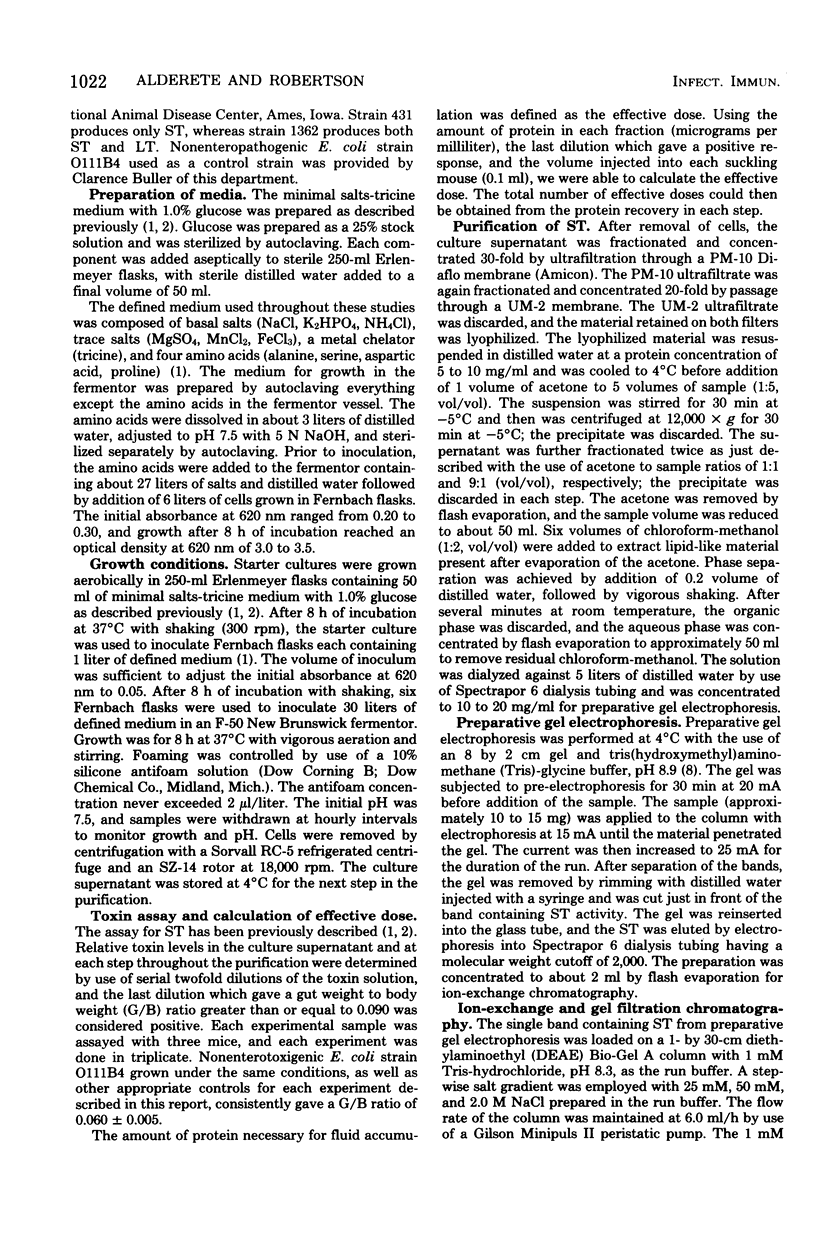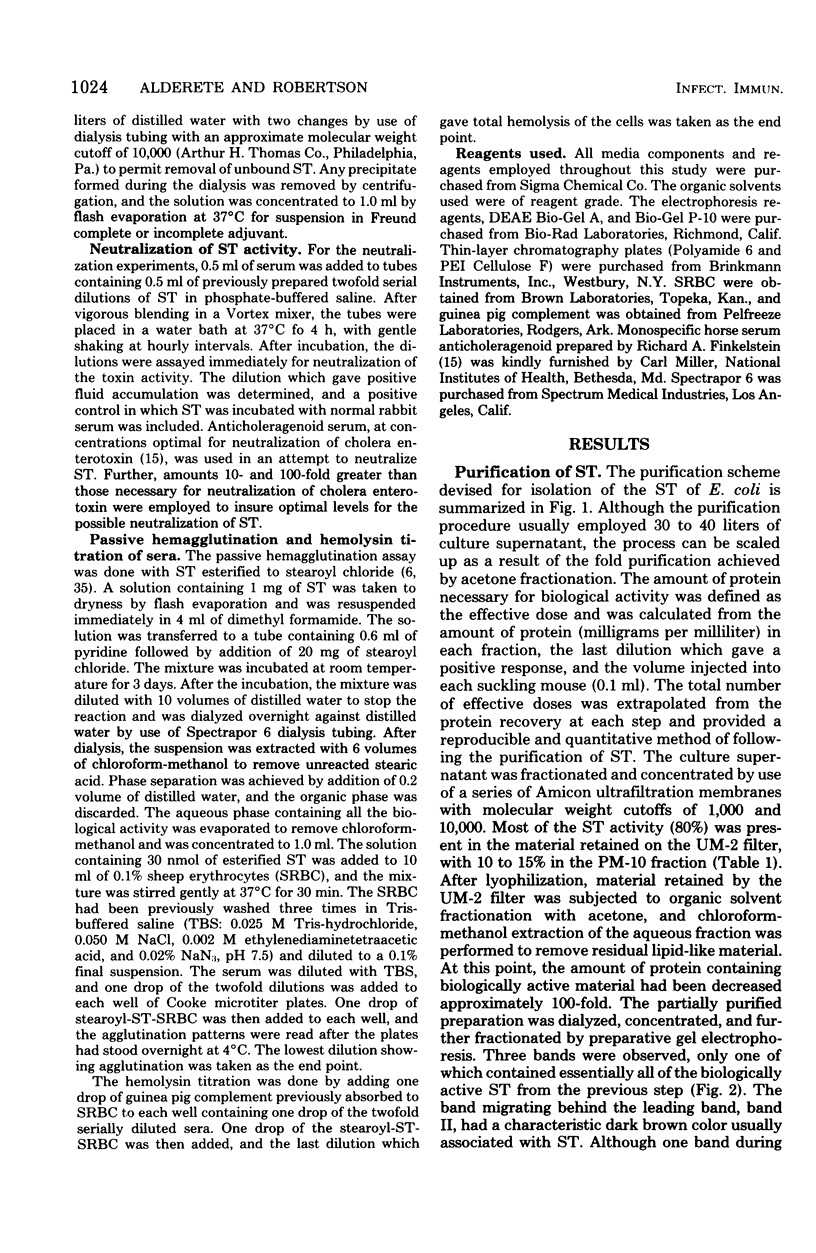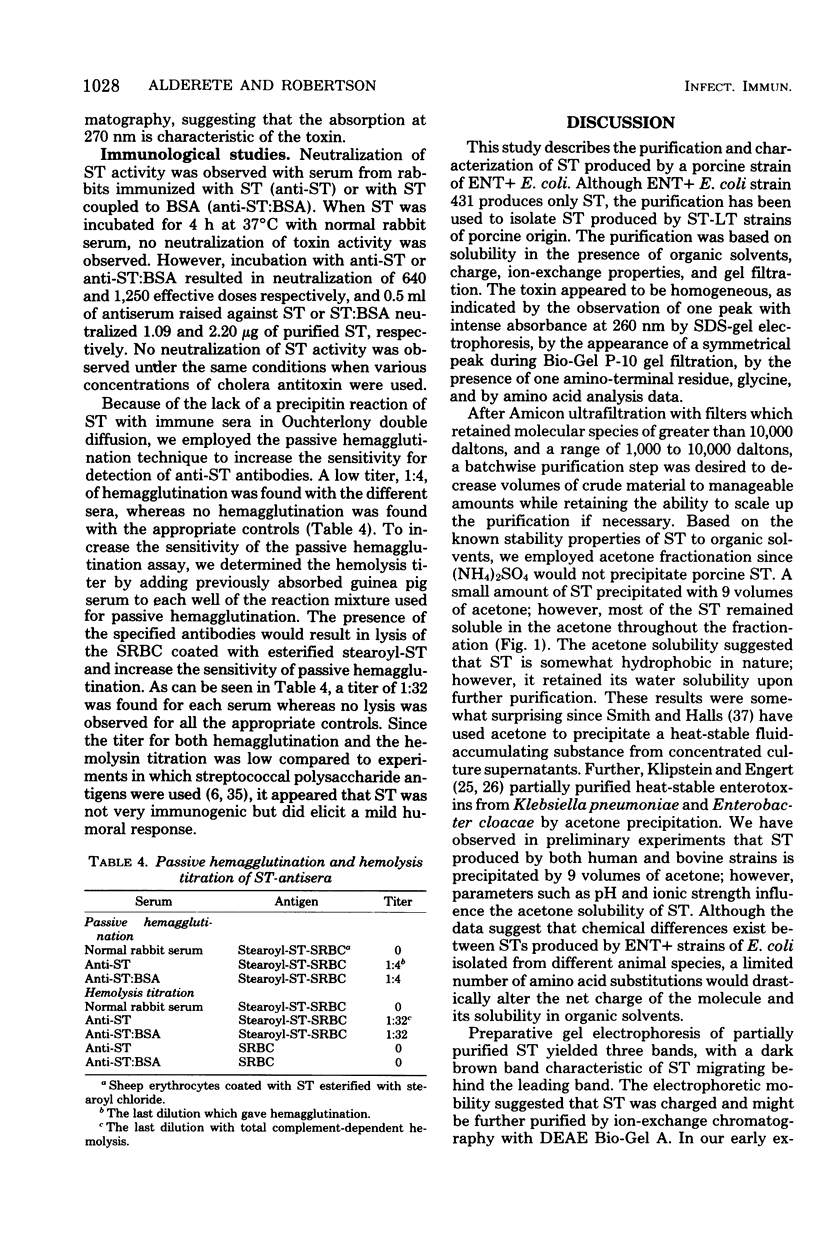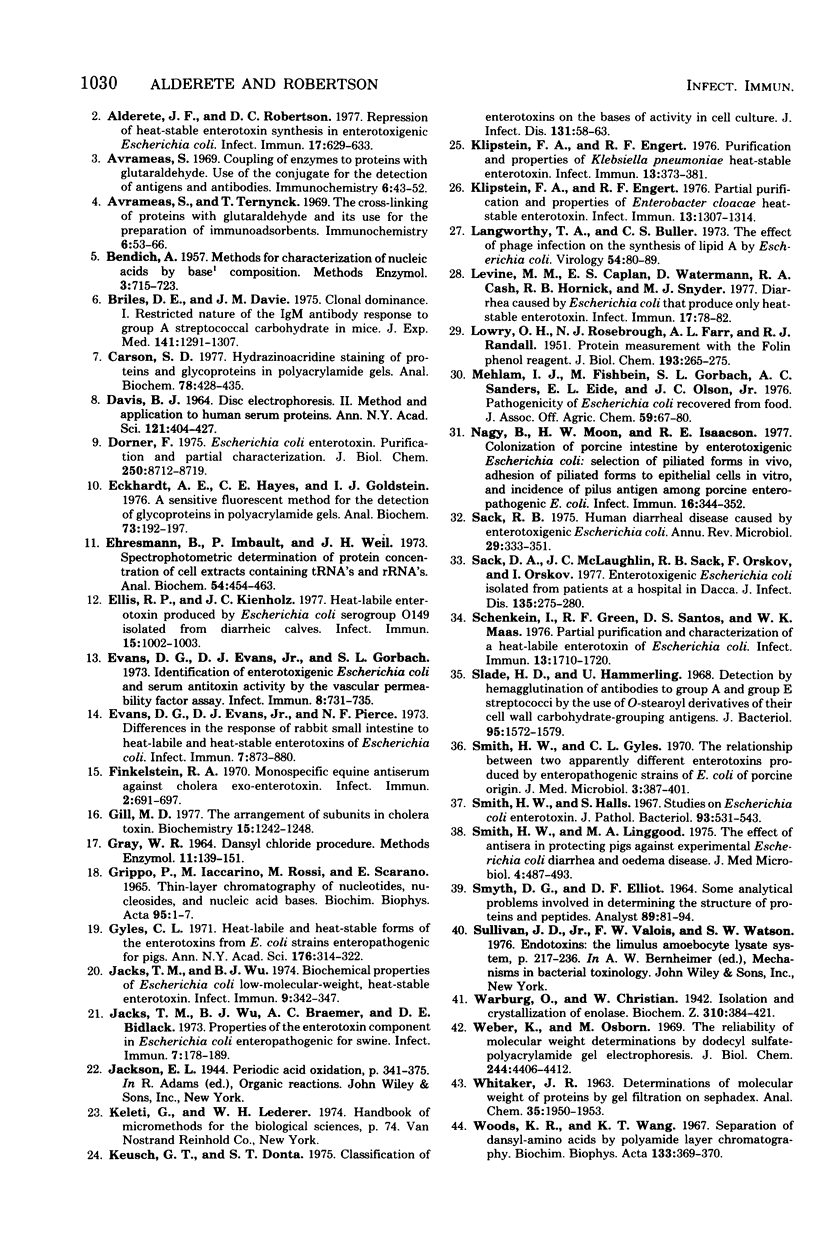Abstract
Heat-stable enterotoxin (ST) produced by porcine strains of enterotoxigenic (ENT+) Escherichia coli has been purified to apparent homogeneity by sequential ultrafiltration, acetone fractionation, preparative gel electrophoresis, diethylaminoethyl Bio-Gel A ion-exchange chromatography, and Bio-Gel P-10 gel filtration. The enterotoxin, purified more than 1,500-fold, exhibited a molecular weight of 4,400, as determined by both sodium dodecyl sulfate-gel electrophoresis and gel filtration. A molecular weight of 5,100, representing 47 residues, was calculated from amino acid analysis data. The amino acid content was distinctive, with an unusually high proportion of cystines and few hydrophobic amino acids. A single amino-terminal residue, glycine, was observed. Purified ST was stable to heating (100°C, 30 min) and did not lose biological activity after treatment with Pronase, trypsin, proteinase K, deoxyribonuclease, ribonuclease, and phospholipase C. Periodic acid oxidation and several organic solvents (acetone, phenol, chloroform, and methanol) had no effect on the biological activity of ST. Further, purified ST was stable to acid treatment at pH 1.0 but lost biological activity at pH values greater than 9.0. Neither lipopolysaccharide nor lipid contamination was evident in purified preparations. A characteristic absorption spectrum was observed during the course of the purification, which shifted from a maximum at 260 nm in crude preparations to 270 nm for the purified toxin. Antiserum obtained from rabbits immunized with ST or ST coupled to bovine serum albumin neutralized the action of the enterotoxin in suckling mice; however, passive hemagglutination and hemolysis titer assays suggested that ST is a poor antigen.
Full text
PDF









Images in this article
Selected References
These references are in PubMed. This may not be the complete list of references from this article.
- Alderete J. F., Robertson D. C. Nutrition and enterotoxin synthesis by enterotoxigenic strains of Escherichia coli: defined medium for production of heat-stable enterotoxin. Infect Immun. 1977 Mar;15(3):781–788. doi: 10.1128/iai.15.3.781-788.1977. [DOI] [PMC free article] [PubMed] [Google Scholar]
- Alderete J. F., Robertson D. C. Repression of heat-stable enterotoxin synthesis in enterotoxigenic Escherichia coli. Infect Immun. 1977 Sep;17(3):629–633. doi: 10.1128/iai.17.3.629-633.1977. [DOI] [PMC free article] [PubMed] [Google Scholar]
- Avrameas S. Coupling of enzymes to proteins with glutaraldehyde. Use of the conjugates for the detection of antigens and antibodies. Immunochemistry. 1969 Jan;6(1):43–52. doi: 10.1016/0019-2791(69)90177-3. [DOI] [PubMed] [Google Scholar]
- Avrameas S., Ternynck T. The cross-linking of proteins with glutaraldehyde and its use for the preparation of immunoadsorbents. Immunochemistry. 1969 Jan;6(1):53–66. doi: 10.1016/0019-2791(69)90178-5. [DOI] [PubMed] [Google Scholar]
- Briles D. E., Davie J. M. Clonal dominance. I. Restricted nature of the IgM antibody response to group A streptococcal carbohydrate in mice. J Exp Med. 1975 Jun 1;141(6):1291–1307. doi: 10.1084/jem.141.6.1291. [DOI] [PMC free article] [PubMed] [Google Scholar]
- Carson S. D. Hydrazinoacridine staining of proteins and glycoproteins in polyacrylamide gels. Anal Biochem. 1977 Apr;78(2):428–435. doi: 10.1016/0003-2697(77)90104-x. [DOI] [PubMed] [Google Scholar]
- DAVIS B. J. DISC ELECTROPHORESIS. II. METHOD AND APPLICATION TO HUMAN SERUM PROTEINS. Ann N Y Acad Sci. 1964 Dec 28;121:404–427. doi: 10.1111/j.1749-6632.1964.tb14213.x. [DOI] [PubMed] [Google Scholar]
- Dorner F. Escherichia coli enterotoxin. Purification and partial characterization. J Biol Chem. 1975 Nov 25;250(22):8712–8719. [PubMed] [Google Scholar]
- Eckhardt A. E., Hayes C. E., Goldstein I. J. A sensitive fluorescent method for the detection of glycoproteins in polyacrylamide gels. Anal Biochem. 1976 May 21;73(1):192–197. doi: 10.1016/0003-2697(76)90154-8. [DOI] [PubMed] [Google Scholar]
- Ehresmann B., Imbault P., Weil J. H. Spectrophotometric determination of protein concentration in cell extracts containing tRNA's and rRNA's. Anal Biochem. 1973 Aug;54(2):454–463. doi: 10.1016/0003-2697(73)90374-6. [DOI] [PubMed] [Google Scholar]
- Ellis R. P., Kienholz J. C. Heat-labile enterotoxin produced by Escherichia coli serogroup O149 isolated from diarrheic calves. Infect Immun. 1977 Mar;15(3):1002–1003. doi: 10.1128/iai.15.3.1002-1003.1977. [DOI] [PMC free article] [PubMed] [Google Scholar]
- Evans D. G., Evans D. J., Jr, Gorbach S. L. Identification of enterotoxigenic Escherichia coli and serum antitoxin activity by the vascular permeability factor assay. Infect Immun. 1973 Nov;8(5):731–735. doi: 10.1128/iai.8.5.731-735.1973. [DOI] [PMC free article] [PubMed] [Google Scholar]
- Evans D. G., Evans D. J., Jr, Pierce N. F. Differences in the response of rabbit small intestine to heat-labile and heat-stable enterotoxins of Escherichia coli. Infect Immun. 1973 Jun;7(6):873–880. doi: 10.1128/iai.7.6.873-880.1973. [DOI] [PMC free article] [PubMed] [Google Scholar]
- Finkelstein R. A. Monospecific equine antiserum against cholera exo-enterotoxin. Infect Immun. 1970 Dec;2(6):691–697. doi: 10.1128/iai.2.6.691-697.1970. [DOI] [PMC free article] [PubMed] [Google Scholar]
- GRIPPO P., IACCARINO M., ROSSI M., SCARANO E. THIN-LAYER CHROMATOGRAPHY OF NUCLEOTIDES, NUCLEOSIDES AND NUCLEIC ACID BASES. Biochim Biophys Acta. 1965 Jan 11;95:1–7. doi: 10.1016/0005-2787(65)90204-2. [DOI] [PubMed] [Google Scholar]
- Gill D. M. The arrangement of subunits in cholera toxin. Biochemistry. 1976 Mar 23;15(6):1242–1248. doi: 10.1021/bi00651a011. [DOI] [PubMed] [Google Scholar]
- Jacks T. M., Wu B. J. Biochemical properties of Escherichia coli low-molecular-weight, heat-stable enterotoxin. Infect Immun. 1974 Feb;9(2):342–347. doi: 10.1128/iai.9.2.342-347.1974. [DOI] [PMC free article] [PubMed] [Google Scholar]
- Jacks T. M., Wu B. J., Braemer A. C., Bidlack D. E. Properties of the enterotoxic component in Escherichia coli enteropathogenic for swine. Infect Immun. 1973 Feb;7(2):178–189. doi: 10.1128/iai.7.2.178-189.1973. [DOI] [PMC free article] [PubMed] [Google Scholar]
- Keusch G. T., Donta S. T. Classification of enterotoxins on the basis of activity in cell culture. J Infect Dis. 1975 Jan;131(1):58–63. doi: 10.1093/infdis/131.1.58. [DOI] [PubMed] [Google Scholar]
- Klipstein F. A., Engert R. F. Partial purification and properties of Enterobacter cloacae heat-stable enterotoxin. Infect Immun. 1976 May;13(5):1307–1314. doi: 10.1128/iai.13.5.1307-1314.1976. [DOI] [PMC free article] [PubMed] [Google Scholar]
- Klipstein F. A., Engert R. F. Purification and properties of Klebsiella pneumoniae heat-stable enterotoxin. Infect Immun. 1976 Feb;13(2):373–381. doi: 10.1128/iai.13.2.373-381.1976. [DOI] [PMC free article] [PubMed] [Google Scholar]
- LOWRY O. H., ROSEBROUGH N. J., FARR A. L., RANDALL R. J. Protein measurement with the Folin phenol reagent. J Biol Chem. 1951 Nov;193(1):265–275. [PubMed] [Google Scholar]
- Langworthy T. A., Buller C. S. The effect of phage infection on the synthesis of lipid A by Escherichia coli. Virology. 1973 Jul;54(1):80–89. doi: 10.1016/0042-6822(73)90116-5. [DOI] [PubMed] [Google Scholar]
- Levine M. M., Caplan E. S., Waterman D., Cash R. A., Hornick R. B., Snyder M. J. Diarrhea caused by Escherichia coli that produce only heat-stable enterotoxin. Infect Immun. 1977 Jul;17(1):78–82. doi: 10.1128/iai.17.1.78-82.1977. [DOI] [PMC free article] [PubMed] [Google Scholar]
- Mehlman I. J., Fishbein M., Gorbach S. L., Sanders A. C., Eide E. L., Olson J. C., Jr Pathogenicity of Escherichia coli recovered from food. J Assoc Off Anal Chem. 1976 Jan;59(1):67–80. [PubMed] [Google Scholar]
- Nagy B., Moon H. W., Isaacson R. E. Colonization of porcine intestine by enterotoxigenic Escherichia coli: selection of piliated forms in vivo, adhesion of piliated forms to epithelial cells in vitro, and incidence of a pilus antigen among porcine enteropathogenic E. coli. Infect Immun. 1977 Apr;16(1):344–352. doi: 10.1128/iai.16.1.344-352.1977. [DOI] [PMC free article] [PubMed] [Google Scholar]
- Sack D. A., McLaughlin J. C., Sack R. B., Orskov F., Orskov I. Enterotoxigenic Escherichia coli isolated from patients at a hospital in Dacca. J Infect Dis. 1977 Feb;135(2):275–280. doi: 10.1093/infdis/135.2.275. [DOI] [PubMed] [Google Scholar]
- Sack R. B. Human diarrheal disease caused by enterotoxigenic Escherichia coli. Annu Rev Microbiol. 1975;29:333–353. doi: 10.1146/annurev.mi.29.100175.002001. [DOI] [PubMed] [Google Scholar]
- Schenkein I., Green R. F., Santos D. S., Maas W. K. Partial purification and characterization of a heat-labile enterotoxin of Escherichia coli. Infect Immun. 1976 Jun;13(6):1710–1720. doi: 10.1128/iai.13.6.1710-1720.1976. [DOI] [PMC free article] [PubMed] [Google Scholar]
- Slade H. D., Hammerling U. [Detection by hemagglutination of antibodies to group A and group E streptococci by the use of O-stearoyl derivatives of their cell wall carbohydrate-grouping antigens]. J Bacteriol. 1968 May;95(5):1572–1579. doi: 10.1128/jb.95.5.1572-1579.1968. [DOI] [PMC free article] [PubMed] [Google Scholar]
- Smith H. W., Gyles C. L. The relationship between two apparently different enterotoxins produced by enteropathogenic strains of Escherichia coli of porcine origin. J Med Microbiol. 1970 Aug;3(3):387–401. doi: 10.1099/00222615-3-3-387. [DOI] [PubMed] [Google Scholar]
- Smith H. W., Halls S. Studies on Escherichia coli enterotoxin. J Pathol Bacteriol. 1967 Apr;93(2):531–543. doi: 10.1002/path.1700930212. [DOI] [PubMed] [Google Scholar]
- Smith H. W., Linggood M. A. The effect of antisera in protecting pigs against experimental Escherichia coli diarrhoea and oedema disease. J Med Microbiol. 1971 Nov;4(4):487–493. doi: 10.1099/00222615-4-4-487. [DOI] [PubMed] [Google Scholar]
- Weber K., Osborn M. The reliability of molecular weight determinations by dodecyl sulfate-polyacrylamide gel electrophoresis. J Biol Chem. 1969 Aug 25;244(16):4406–4412. [PubMed] [Google Scholar]
- Woods K. R., Wang K. T. Separation of dansyl-amino acids by polyamide layer chromatography. Biochim Biophys Acta. 1967 Feb 21;133(2):369–370. doi: 10.1016/0005-2795(67)90078-5. [DOI] [PubMed] [Google Scholar]



